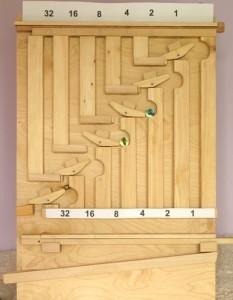The binary number system is what runs almost all modern digital electronics and is used in several schools of higher mathematics. If you are unfamiliar with binary mathematics, it is a simplified version of decimal math that requires the use of only two numbers, a 1 and a 0. Because it is such a straightforward system it is ideal for almost all modern computers and computation devices. While the modern binary number system was developed way back in 1679, it was based on concepts that date all the way back to ancient Egypt and the I Ching number system from 9th century BC China.
This 3D Printed Binary Adding Machine was designed and printed by Thingiverse user and 3D printing hobbyist Don Schaefer and based on a wooden design developed by a maker named Matthias Wandel. The original wooden machine was based around a simple concept of what Wandel calls a “flipflop” piece that can represent either a 1 or a 0 depending on its positioning. When a marble falls on the right of the flipflop it will stay in place until a second marble falls to the left of the flipflop. A single dropped marble will start a cascading effect that represents how computers use binary numbers to function.
Schaefer decided to design a 3D printable version of the device for educational purposes, with the idea that teachers or students could easily print out their own machine. 3D printing is much easier than wood working, and would allow them to teach the basics of binary counting. He originally used the plans for a wooden version that Wandel posted on his website; however, they were not easily translatable to something that could be 3D printed.
“This quickly became a 3D printing nightmare. I needed to come up with something that maintained basic functionality that was also 3D printer friendly. I knew early on that the goal was 1/2 scale of the wooden version. This meant replacing a marble with a 5/16 steel ball. The steel ball is the only non printable part of this project,” explained Schaefer.
The machine was designed entirely in Solidworks and will need to be 3D printed in almost twenty individual parts. Just the two largest sections of the device alone required about six hours of 3D printing each, with the smaller parts needing several more hours. However, Schaefer included a Simplify3D file for the base assembly that has custom supports that will trim close to an hour off of the job. It will also help prevent the supports from getting on the return ramp, making cleaning and post processing faster.
The design initially included built-in pins on the upper assembly that were intended to hold the flipflop parts in place. Unfortunately, Schaefer discovered that they were far too fragile and easily broke off. He redesigned the assembly and removed the pins, replacing them with a pin that prints separately that can be pushed in from the back. Thankfully the new pin is much more durable and holds up to the constant motion of the flipflops quite well.
Here is a brief demonstration video of Schaefer’s 3D printed version of the device:
And here is a video demonstration of the original wooden Wandel design:
As each flipflop moves back and forth they demonstrate binary bits and bytes in physical form, with the steel balls registering the sum of all the values that are being added together. While his first version glitched slightly the first time that it added up to 32, the machine worked perfectly with each subsequent use. Schaefer is still developing his 3D Printed Binary Adding Machine and intends on having his second version of the device ready by the end of September.
You can download the digital files for your own machine over on Thingiverse, and learn more about all of Matthias Wandel’s cool woodworking projects and marble machines on his website. And let us know what you think of this 3D printing project over on our 3D Printed Binary Adding Machine forum thread at 3DPB.com.
Subscribe to Our Email Newsletter
Stay up-to-date on all the latest news from the 3D printing industry and receive information and offers from third party vendors.
Print Services
Upload your 3D Models and get them printed quickly and efficiently.
You May Also Like
3D Printing News Briefs, July 2, 2025: Copper Alloys, Defense Manufacturing, & More
We’re starting off with metals in today’s 3D Printing News Briefs, as Farsoon has unveiled a large-scale AM solution for copper alloys, and Meltio used its wire-laser metal solution to...
Etsy Design Rule Change Reduces Selection of 3D Printed Goods
Online marketplace Etsy has implemented a rule change requiring all 3D printed goods on the site to be original designs. The update to the site’s Creativity Standards states, ¨Items produced using...
Siraya Tech Introduces New Elastomer 3D Printing Materials, Including Foaming TPU
California company Siraya Tech, founded in 2019 with a focus on material science, customer focus, and agility, develops high-quality 3D printing materials that meet the needs of creators, hobbyists, and...
3D Printing News Briefs, April 12, 2025: RAPID Roundup
The news from last week’s RAPID+TCT in Detroit just keeps on coming! That’s why today’s 3D Printing News Briefs is another RAPID Roundup of more exciting announcements from the trade...



































